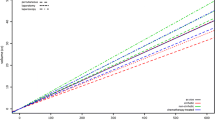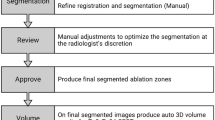Abstract
Background
Microwave ablation (MWA) has been recently recognized as a technology to overcome the limitations of radiofrequency ablation. The aim of the current study was to evaluate the safety and efficacy of a new 2.45-GHz thermosphere MWA system in the treatment of malignant liver tumors.
Methods
This was a prospective IRB-approved study of 18 patients with malignant liver tumors treated with MWA within a 3-month time period. Tumor sizes and response to MWA were obtained from triphasic liver CT scans done before and after MWA. The ablation zones were assessed for complete tumor response and spherical geometry.
Results
There were a total of 18 patients with an average of three tumors measuring 1.4 cm (range 0.2–4). Ablations were performed laparoscopically in all, but three patients who underwent combined liver resection. A single ablation was created in 72 % and overlapping ablations in 28 % of lesions. Total ablation time per patient was 15.6 ± 1.9 min. There was no morbidity or mortality. At 2-week CT scans, there was 100 % tumor destruction, with no residual lesions. Roundness indices A, B and transverse were 1.1, 0.9 and 0.9, respectively, confirming the spherical nature of ablation zones.
Conclusions
To the best of our knowledge, this is the first report of a new thermosphere MWA technology in the laparoscopic treatment of malignant liver tumors. The results demonstrate the safety of the technology, with satisfactory spherical ablation zones seen on post-procedural CT scans.





Similar content being viewed by others
References
Berber E, Siperstein AE (2007) Perioperative outcome after laparoscopic radiofrequency ablation of liver tumors: an analysis of 521 cases. Surg Endosc 21(4):613–618
Kennedy TJ, Cassera MA, Khajanchee YS, Diwan TS, Hammill CW, Hansen PD (2010) Laparoscopic radiofrequency ablation for the management of colorectal liver metastases: 10-year experience. J Surg Oncol 107(4):324–328
Iannitti DA, Martin RC, Simon CJ, Hope WW, Newcomb WL, McMasters KM, Dupuy D (2007) Hepatic tumor ablation with clustered microwave antennae: the US Phase II trial. HPB 9:120–124
Martin RC, Scoggins CR, McMasters KM (2010) Safety and efficacy of microwave ablation of hepatic tumors: a prospective review of a 5-year experience. Ann Surg Oncol 17:171–178
Simon CJ, Dupuy DE, Mayo-Smith WW (2005) Microwave ablation: principles and applications. Radiographics 25(Suppl. 1):S69–S83
Huang S, Yu J, Liang P, Yu X, Cheng Z, Han Z, Li Q (2014) Percutaneous microwave ablation for hepatocellular carcinoma adjacent to large vessels: a long-term follow-up. Eur J Radiol 83(3):552–558
Shibata T, Niinobu T, Ogata N, Takami M (2000) Microwave coagulation therapy for multiple hepatic metastases from colorectal carcinoma. Cancer 89(2):276–284
Yu J, Liang P, Yu X, Liu F, Chen L, Wang Y (2011) A comparison of microwave ablation and bipolar radiofrequency ablation both with an internally cooled probe: results in ex vivo and in vivo porcine livers. Eur J Radiol 79(1):124–130
Wright SA, Lee FT, Mahvi DM (2003) Hepatic microwave ablation with multiple antennae results in synergistically larger zones of coagulation necrosis. Ann Surg Oncol 10:275–283
Gravante G, Ong SL, Metcalfe MS, Strickland A, Dennison AR, Lloyd DM (2008) Hepatic microwave ablation: a review of the histological changes following thermal damage. Liver Int 28(7):911–921
Park MJ, Kim YS, Rhim H, Lim HK, Lee MW, Choi D (2011) A comparison guided percutaneous radiofrequency ablation of medium-sized hepatocellular carcinoma with a cluster electrode or a single electrode with a multiple overlapping ablation technique. J Vasc Interv Radiol 22(6):771–779
de Baere T, Deschamps F (2014) New tumor ablation techniques for cancer treatment (microwave, electroporation). Diagn Interv Imaging 95(7–8):677–682
Stuchly MA, Athey TW, Stuchly SS, Samaras GM, Taylor G (1981) Dielectric properties of animal tissues in vivo at frequencies10 MHz–1 GHz. Bioelectromagnetics 2:93–103
Brace CL, Hinshaw JL, Laeseke PF, Sampson LA, Lee FT Jr (2009) Pulmonary thermal ablation: comparison of radiofrequency and microwave devices by using gross pathologic and CT findings in a swine model. Radiology 25:705–711
Yu NC, Raman SS, Kim YJ, Lassman C, Chang X, Lu DS (2008) Microwave liver ablation: influence of hepatic vein size on heat-sink effect in a porcine model. J Vasc Interv Radiol 19:1087–1092
Leung U, Kuk D, D’Angelica MI, Kingham TP, Allen PJ, DeMatteo RP, Jarnagin WR, Fong Y (2015) Long-term outcomes following microwave ablation for liver malignancies. Br J Surg 102(1):85–91
Engstrand J, Nilsson H, Jansson A, Isaksson B, Freedman J, Lundell L, Jonas E (2014) A multiple microwave ablation strategy in patients with initially unresectable colorectal cancer liver metastases—a safety and feasibility study of a new concept. Eur J Surg Oncol 40(11):1488–1493
Stättner S, Jones RP, Yip VS, Buchanan K, Poston GJ, Malik HZ, Fenwick SW (2013) Microwave ablation with or without resection for colorectal liver metastases. Eur J Surg Oncol 39(8):844–849
Ierardi AM, Floridi C, Fontana F, Chini C, Giorlando F, Piacentino F, Brunese L, Pinotti G, Bacuzzi A, Carrafiello G (2013) Microwave ablation of liver metastases to overcome the limitations of radiofrequency ablation. Radiol Med 118(6):949–961
Groeschl RT, Pilgrim CH, Hanna EM, Simo KA, Swan RZ, Sindram D, Martinie JB, Iannitti DA, Bloomston M, Schmidt C, Khabiri H, Shirley LA, Martin RC, Tsai S, Turaga KK, Christians KK, Rilling WS, Gamblin TC (2014) Microwave ablation for hepatic malignancies: a multiinstitutional analysis. Ann Surg 259(6):1195–1200
Sindram D, Simo KA, Swan RZ, Razzaque S, Niemeyer DJ, Seshadri RM, Hanna E, McKillop IH, Iannitti DA, Martinie JB (2015) Laparoscopic microwave ablation of human liver tumors using a novel three-dimensional magnetic guidance system. HPB (Oxford) 17(1):87–93
Disclosures
Eren Berber has no conflict of interest or financial ties to disclose.
Author information
Authors and Affiliations
Corresponding author
Rights and permissions
About this article
Cite this article
Berber, E. Laparoscopic microwave thermosphere ablation of malignant liver tumors: an initial clinical evaluation. Surg Endosc 30, 692–698 (2016). https://doi.org/10.1007/s00464-015-4261-3
Received:
Accepted:
Published:
Issue Date:
DOI: https://doi.org/10.1007/s00464-015-4261-3




